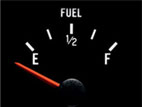Dependence on Foreign Oil. Global Warming. Offshore Drilling. Smog. Concern about the environmental and geopolitical costs of our nation’s 140 billion gallon a year gasoline addiction has never been higher. Recent polls have found that 91 percent of Americans believe our nation is facing an energy crisis and 86 percent say they want their government to help develop alternative energy sources.

Ethanol 101: E10 and E85
Legend has it that during Prohibition, bootleggers used to put their brew in the gas tanks of their getaway cars. Today, approximately 70% of all gasoline sold in the U.S. contains ethanol. Most of that gasoline is what’s known as “E10” – a mixture that is 90 percent or more unleaded gasoline and ten percent or less ethanol. More >

Ethanol: The Pollution Solution
Currently, transportation is the largest single source of air pollution in the United States producing nearly two-thirds of the carbon monoxide, a third of the nitrogen oxides, and a quarter of the hydrocarbons in our atmosphere. Adding ethanol to gasoline changes that formula dramatically. More >

Waste to Wheels: The Cellulosic Revolution
At the moment, most of the ethanol produced in the United States starts out as corn. Only the starchy part of the corn kernel is used; the leftover oils, fibers, and proteins are used as animal feed. But most biofuels experts believe that corn ethanol is a transitional technology. More >

Face Off: Producing Cellulosic Ethanol: Sugar Platform Vs. Thermo-Chemical
There are two ways to convert biomass to cellulosic ethanol: sugar platform and thermo-chemical conversion processes. More >

Debunking Ethanol Myths
A lot of misinformation about ethanol circulates on the airwaves and the Internet, leaving consumers and opinion-makers confused about ethanol’s economic and environmental costs. More >

Ethanol Equals Energy Independence: A Lesson from Brazil
Can ethanol help the U.S. achieve energy independence? The answer lies to the south of us in the developing nation of Brazil. With large increases in demand for energy due to rapid industrialization, Brazil has actively sought ways to reduce its dependence on foreign oil. More >

What Is the Federal Government Doing to Support Ethanol?
The United States has supported the development of the ethanol industry using a combination of financial support and incentives. Thanks primarily to the Clean Air Act Amendments of 1990, the Jobs Creation Act of 2004, and Energy Policy Act of 2005, ethanol consumption has increased from one billion gallons in the early 1990s to approximately 7 billion gallons in 2007. More >

Where Do We Go from Here?
Ethanol production is increasing at an impressive clip. Right now there are more than 170 plants capable of producing a total of 10.7 billion gallons of ethanol per year. More plants – capable of producing another 2.3 billion gallons of ethanol per year – are under construction. More >
Six Things You Can Do Right Now
- Contact your congressional representative or your senator to demand support for legislation like the Energy Independence and Security Act of 2007 and the 2008 Farm Bill.
- Buy a flex-fuel car.
- Join a flex-fuel vehicle club.
- Find an E85 station near you.
- Join an ethanol coalition.
- to a friend.


